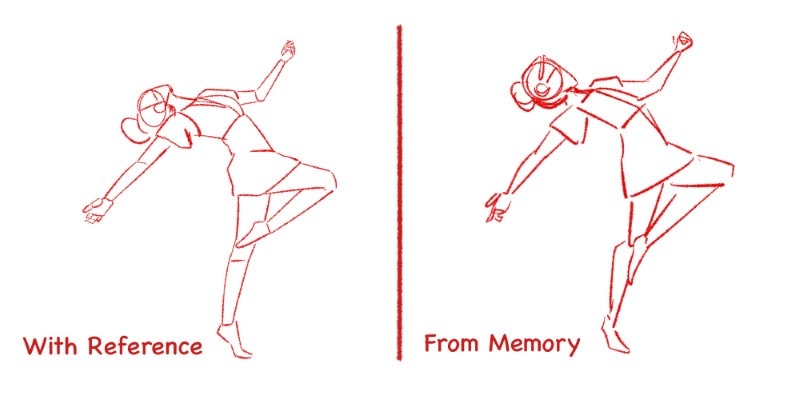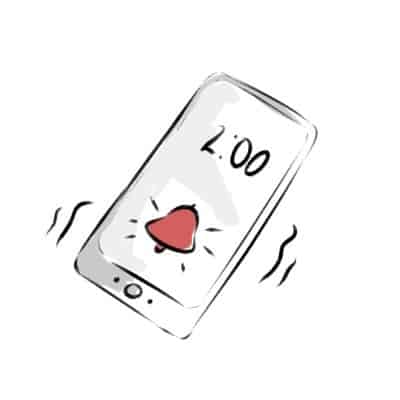To practice gesture drawing and study the human figure more in-depth, you must do some great gesture drawing exercises!
Whether a beginner or a professional artist, these exercises will help you train your brain to capture the human anatomy much faster (and better).
So let’s review some exercises you can do to improve your skills at drawing gestures.
Table Of Contents
Draw Timed Gestures (Increasingly Shorter!)

One of the best exercises (although sometimes a bit nerve-wracking) to improve at drawing gestures is to time yourself!
Now, this can give you some anxiety, but relax, you’ve got this!
We’ll start with an easier version of this exercise and then make it more difficult as we go.
So here are the steps for this gesture drawing exercise:
- Choose A Photo Reference (here’s an article with the best free websites to get pose references)
- Put A Timer For 2 Minutes And Start It
- Draw The Gesture Of The Pose With Long Loose Lines
- Keep going until the timer ends!
This is very simple to follow, but your first few gestures might look a bit rushed or “unfinished”. Don’t worry about this!
It takes time and practice to get better at gesture drawing.
One you’re done with the 2 Minutes exercise, it’s time to reduce that timer!
Draw the same pose again, with the same reference image, but with a timer for 1 minute.
And then once again, for 30 seconds!
Now put all of those gesture exercises side by side and check the differences.
Which part did you focus on more? Which part isn’t recognizable?
This will allow you to understand better what part of the pose drawing is more important when drawing it.
And will help you learn how to draw poses and figures in a faster, and higher quality, way.
Once you’ve done a couple of these, go back and check your first gesture drawing of the session.
Can you see your improvement?
It just takes time and patience, so keep going!
Memory Drawing Practice

Time to practice some memory drawing!
With this gesture exercise, you’ll be doing something similar to the timed one before.
Start by setting a timer you’re comfortable with (30 seconds, 1 minute, 2 minutes, etc) and draw a pose based on a reference image.
Pay close attention to the line of action of the body, the shapes, the negative and positive space, and keep drawing the gesture.
Once the timer is up, stop drawing.
And now, just do the same… but without the reference image.
Grab a new sheet of paper, make a new canvas in your drawing software, or flip your sketchbook page and get ready.

Set the timer and start drawing the same photo you did before, without looking at the previous photo.
Try to remember the exact shapes and lines you’ve used to capture the gesture of the figure.
When the timer is up, compare both drawings!
What did you miss? How different is the pose?
Try to understand what did you struggle with, and why the image looks different.
Memory is hard to train, but if you keep going this exercise, you’ll be able to draw from memory MUCH faster than before.
Not just gestures, but everything you want to draw!
Draw The Whole Gesture Using A Single Line

For a fun take on a gesture exercise, try to draw an entire gesture using a single line!
It does require a bit of planning, but this can be a very fun gesture practice.
- Grab a reference photo
- Draw the entire gesture with one line without your tool ever leaving the paper/tablet
That’s it!
As you practice, you’ll better understand the best places to start so that you can draw your pose perfectly.
This might sound like a silly exercise, but it’s fun AND teaches you quite a bit.
So do give it a try.
Use A New Material or Tool

When improving at ANY drawing skill, a good change of pace is to try a new drawing material!
Maybe you’ll find your new favorite tool, or maybe you just have some fun.
Either way it’s a win-win.
Usually dry media works best when drawing quick sketches and gestures, but if you’d like to try some wet media, go ahead!
Here are some tools you can try:
- Charcoal
- Markers
- Pastels
- New Software (like these drawing software for beginners)
- Gouache Paint
- A New Drawing Tablet
And so much more!
Find a material or tool that you’re not used to and have fun doing some gesture drawing.
Draw Gestures Using Only Shapes

One more fun drawing exercise, try drawing a gesture using only shapes!
This will set a limit to your workflow and make you think outside the box.
How can you draw figures, a muscle, a leg, with only shapes?
Focus on drawing:
- Triangles
- Squares
- Rectangles
- Trapezoids
- Circles
And see how you can fit that into the gesture of the pose you’re drawing!
This is almost a figure drawing exercise, (and it can be done to draw the figure as well), but try to use it for gesture at this stage.
Keep an open mind, and have fun! This can be a very beneficial gesture drawing exercise for the improvement of your art skills.
Draw the Gesture of Your Favorite Artwork

One of the best ways to learn any art subject is to look at and learn from professional artwork.
If you have one or two favorite art pieces you just love to see, use them as reference!
- Choose One Of Your Favorite Artists’ Artwork
- Draw The Gesture Based On It!
Of course, this works best if the artwork has a full drawing of a complete figure. So try and pick one where you can choose the entire pose!
You can grab artwork from an old master (like these) or some modern artists.
What’s important is that it’s professional-looking work, with artists you love.
Study their work intensively, and remember not to claim these drawings as original work. Reference your sources if you post them up online!
And more importantly, have fun.
Try Drawing With Your Other Hand

Lastly, let’s go for a fun and dynamic gesture drawing exercise!
This exercise is pure fun to do, but the quality of your drawing will not be the best unless you’re ambidextrous.
Simply:
- Grab A Reference Photo
- Draw The Gesture (With Your Non-Dominant Hand!)
That’s it!
For extra fun, draw the gesture with your usual hand, and then do it again with your non-dominant hand.
The comparison of both gesture drawings can be hilarious to look at!
So I highly recommend you try this exercise out to unwind at the end of the day.
Related Questions
Let’s now go over some related questions on gesture drawing exercises.
Where To Get Gesture Drawing Inspiration
When looking for gesture drawing inspiration, I recommend you check old masters works.
These are professional artists that have honed their craft through many years, so they can certainly teach you a thing or two.
You just need to pay close attention to their gesture practice!
You can find some beautiful gesture drawing inspiration here, with examples from old masters!
What Are Some Tips To Improve At Gesture Drawing?
To improve quicker at gesture drawing, I recommend a few tips.
Including:
- Paying attention to negative and positive space
- Keeping your lines loose and confident
You can check my entire article on gesture drawing tips (with examples to follow) here.
It does take time to improve, but if you follow these tips, I’m sure you’ll boost your skills much faster.
And if you want a step-by-step guide on gesture drawing, check out my Complete Guide on Gesture Drawing here!
Or join my Complete Figure Drawing Course to get an entire video section on drawing gestures!
Patricia Caldeira is the main writer here at Don Corgi. She's an art teacher with over 20.000 happy students across many platforms and courses!
Enjoy your stay and as always:
Keep on drawing!



